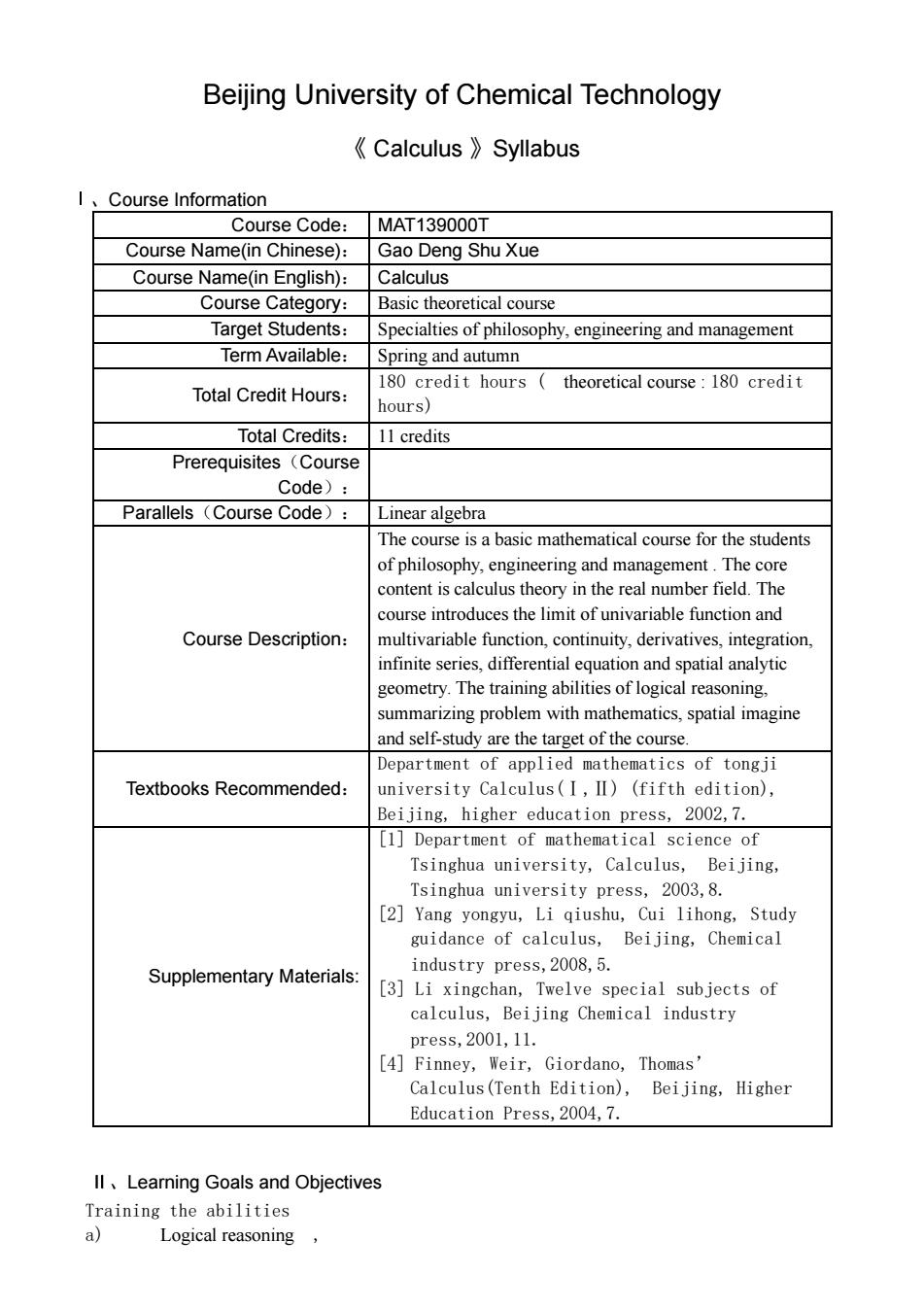
Beijing University of Chemical Technology 《Calculus》Syllabus 、Course Information Course Code:MAT139000T Course Name(in Chinese): Gao Deng Shu Xue Course Name(in English): Calculus Course Category: Basic theoretical course Target Students: Specialties of philosophy,engineering and management Term available:I Spring and autumn Total Credit Hours: 180 credit hours theoretical course:180 credit hours) Total Credits. 11 credits Prerequisites (Course Code): Parallels (Course Code): Linear algebra The course is a basic mathematical course for the students of philosophy,engineering and management.The core content is calculus theory in the real number field.The course introduces the limit of univariable function and Course Description infinite series,differential equation and spatial analytic geometry.The training abilities of logical reasoning, summarizing problem with mathematics,spatial imagine and self-study are the target of the course. Department of applied mathematics of tongji Textbooks Recommended: university Calculus(I.I)(fifth edition). Beiiing.higher education press.2002.7. [1]Department of mathematical science of Tsinghua university,Calculus, Bei jing, Tsinghua university press.2003.8. [2]Yang yongyu,Li qiushu,Cui lihong,Study guidance of calculus, Beijing,Chemical Supplementary Materials: industry press,2008,5. [3]Li xingchan,Twelve special subjects of calculus,Beijing Chemical industry press,.2001,11 [4]Finney,Weir,Giordano,Thomas' Calculus(Tenth Edition),Beijing,Higher Education Press.2004.7. ll Learning Goals and Objectives Training the abilities a) Logical reasoning
Beijing University of Chemical Technology 《 Calculus 》Syllabus Ⅰ、Course Information Course Code: MAT139000T Course Name(in Chinese): Gao Deng Shu Xue Course Name(in English): Calculus Course Category: Basic theoretical course Target Students: Specialties of philosophy, engineering and management Term Available: Spring and autumn Total Credit Hours: 180 credit hours ( theoretical course : 180 credit hours) Total Credits: 11 credits Prerequisites(Course Code): Parallels(Course Code): Linear algebra Course Description: The course is a basic mathematical course for the students of philosophy, engineering and management . The core content is calculus theory in the real number field. The course introduces the limit of univariable function and multivariable function, continuity, derivatives, integration, infinite series, differential equation and spatial analytic geometry. The training abilities of logical reasoning, summarizing problem with mathematics, spatial imagine and self-study are the target of the course. Textbooks Recommended: Department of applied mathematics of tongji university Calculus(Ⅰ,Ⅱ) (fifth edition), Beijing, higher education press, 2002,7. Supplementary Materials: [1] Department of mathematical science of Tsinghua university, Calculus, Beijing, Tsinghua university press, 2003,8. [2] Yang yongyu, Li qiushu, Cui lihong, Study guidance of calculus, Beijing, Chemical industry press,2008,5. [3] Li xingchan, Twelve special subjects of calculus, Beijing Chemical industry press,2001,11. [4] Finney, Weir, Giordano, Thomas’ Calculus(Tenth Edition), Beijing, Higher Education Press,2004,7. Ⅱ、Learning Goals and Objectives Training the abilities a) Logical reasoning
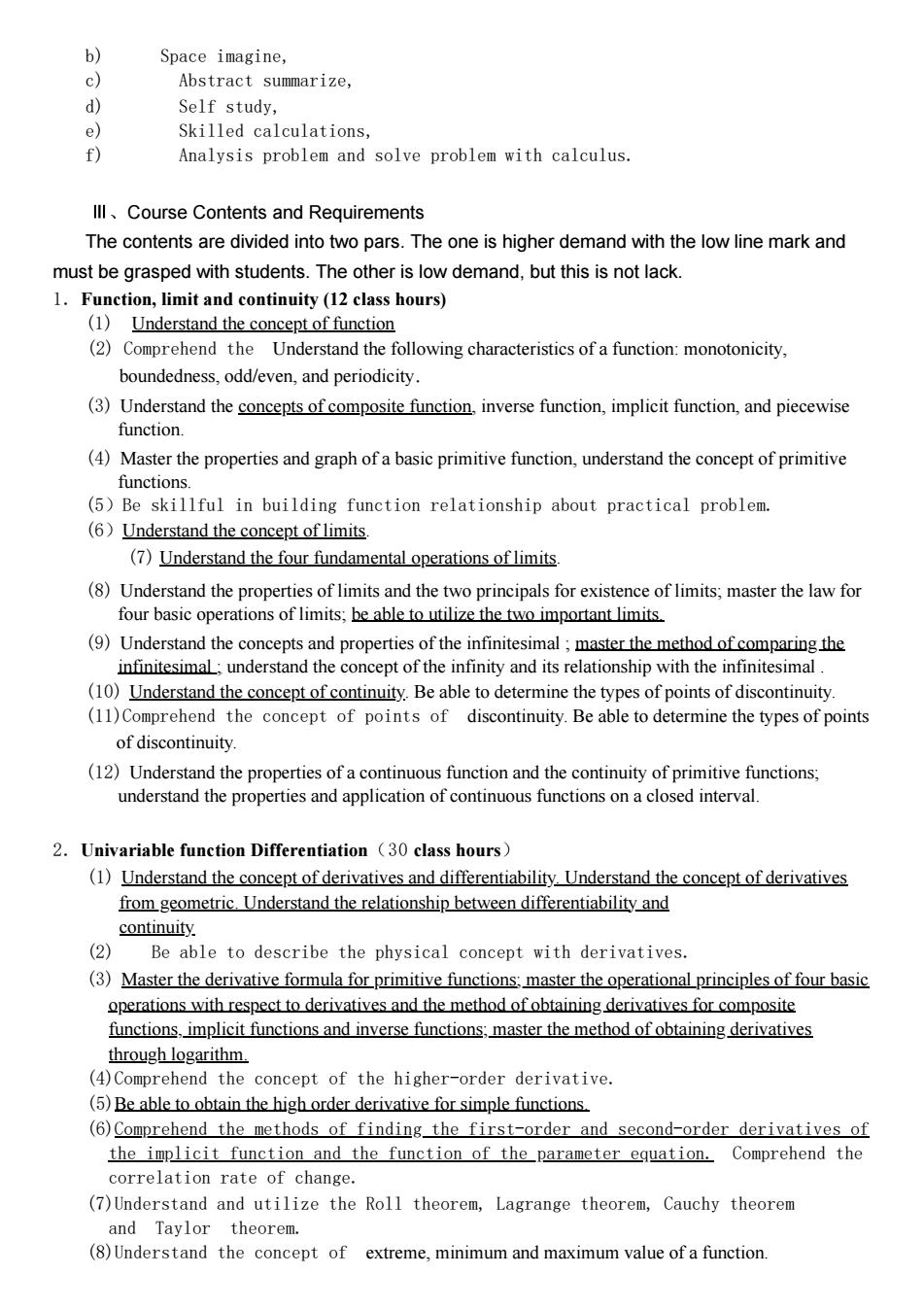
b) Space imagine, c) Abstract summarize, Self study, Skilled calculations, Analysis problem and solve problem with calculus. lⅢl、Course Contents and Requirements The contents are divided into two pars.The one is higher demand with the low line mark and must be grasped with students.The other is low demand,but this is not lack. 1.Function,limit and continuity(12 class hours) (1)Understand the concept of function (2)Comprehend the Understand the following characteristics of a function:monotonicity boundedness.odd/even.and periodicity. (3)Understand the of composite function.inverse function,implicit function.and piecewise function. (4)Master the properties and graph ofa basic primitive function,understand the concept of primitive (5)Be skillful in building function relationship about practical problem (6)Understand the concept of limits. (7)Understand the four fundamental operations of limits. (8)Understand the properties of limits and the two principals for existence of limits:master the law for four basic operation s of limits,be able to utilize the t o important limits (9)Understand the concepts and properties of the infinitesimal:master the method of comparing the infinitesimal:understand the concept of the infinity and its relationship with the infinitesimal. (10)Understand the concept of continuity.Be able to determine the types of points of discontinuity. (11)Comprehend the cept of points ntinuity.Be able to determine the types of point of discontinuity. (12)Understand the properties a nuous function and the continuity of p nitive functions understand the properties and application of continuous functionsonaclosed interval 2.Univariable function Differentiation (30 class hours) (1)Understand the concept of derivatives and differentiability.Understand the concept of derivatives from geometric.Understand the relationship between differentiability and continuity. Be able to describe the physical concept with derivatives. (3)Master the derivative formula for primitive functions:master the operational principles of four basic operations with respect to derivatives and the method of obtaining derivatives for composite functions implicit functions and inverse functions master the method of obtaining derivatives through logarithm. (4)Comprehend the concept of the higher-order derivative. (5)Be able to obtain the high order derivative for simple functions. (6)Comprehend the methods of finding the first-order and second-order derivatives of the implicit function and the function of the parameter equation.Comprehend the correlation rate of change. (7)Understand and utilize the Roll theorem,Lagrange theorem,Cauchy theorem and Taylor theorem. (8)Understand the concept of extreme,minimum and maximum value of a function
b) Space imagine, c) Abstract summarize, d) Self study, e) Skilled calculations, f) Analysis problem and solve problem with calculus. Ⅲ、Course Contents and Requirements The contents are divided into two pars. The one is higher demand with the low line mark and must be grasped with students. The other is low demand, but this is not lack. 1.Function, limit and continuity (12 class hours) (1) Understand the concept of function (2) Comprehend the Understand the following characteristics of a function: monotonicity, boundedness, odd/even, and periodicity. (3) Understand the concepts of composite function, inverse function, implicit function, and piecewise function. (4) Master the properties and graph of a basic primitive function, understand the concept of primitive functions. (5)Be skillful in building function relationship about practical problem. (6)Understand the concept of limits. (7) Understand the four fundamental operations of limits. (8) Understand the properties of limits and the two principals for existence of limits; master the law for four basic operations of limits; be able to utilize the two important limits. (9) Understand the concepts and properties of the infinitesimal ; master the method of comparing the infinitesimal ; understand the concept of the infinity and its relationship with the infinitesimal . (10) Understand the concept of continuity. Be able to determine the types of points of discontinuity. (11)Comprehend the concept of points of discontinuity. Be able to determine the types of points of discontinuity. (12) Understand the properties of a continuous function and the continuity of primitive functions; understand the properties and application of continuous functions on a closed interval. 2.Univariable function Differentiation(30 class hours) (1) Understand the concept of derivatives and differentiability. Understand the concept of derivatives from geometric. Understand the relationship between differentiability and continuity (2) Be able to describe the physical concept with derivatives. (3) Master the derivative formula for primitive functions; master the operational principles of four basic operations with respect to derivatives and the method of obtaining derivatives for composite functions, implicit functions and inverse functions; master the method of obtaining derivatives through logarithm. (4)Comprehend the concept of the higher-order derivative. (5)Be able to obtain the high order derivative for simple functions. (6)Comprehend the methods of finding the first-order and second-order derivatives of the implicit function and the function of the parameter equation. Comprehend the correlation rate of change. (7)Understand and utilize the Roll theorem, Lagrange theorem, Cauchy theorem and Taylor theorem. (8)Understand the concept of extreme, minimum and maximum value of a function
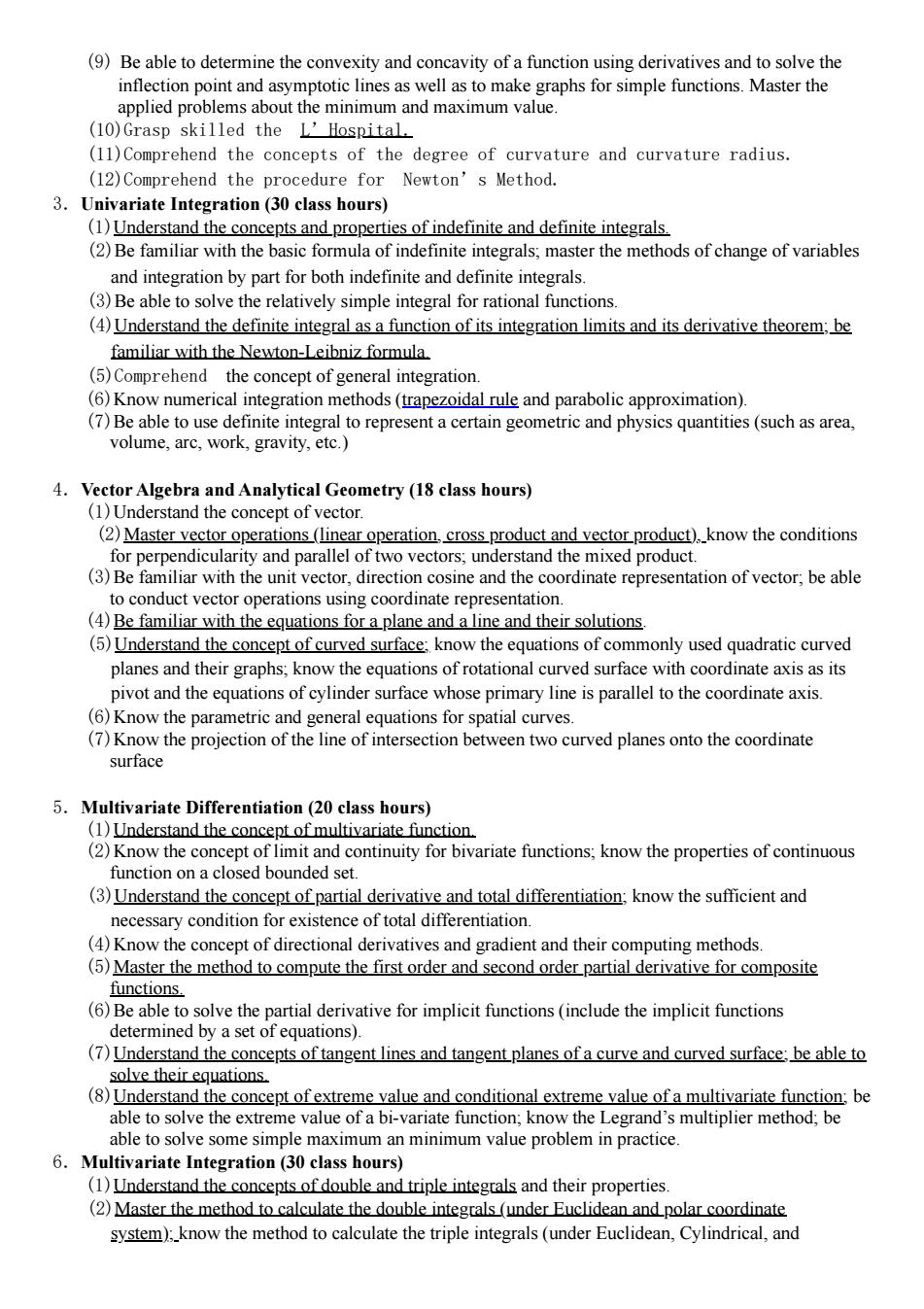
inflec asymptotic lines as well as to mak Grasp skille (11)Comprehend the concepts of the degree of curvature and curvature radius. (12)Comprehend the nrocedure for Newton's Method. 3.Univariate Integration(30 class hours) (1)Understand the conce ts and pro rties of indefinite and definite integrals ()Be with the basic master the nods of change of variables and integration by part for both indefinite and definite integrals (3)Be able to solve the relatively simple integral for rational functions. (4)Understand the definite integral as a function of its integration limits and its derivative theorem:be familiar with the Newton-Leibni formula (5)Comprehend the concept of general integration. (6)Know numerical integration methods(trapezoidal rule and parabolic approximation). (7)Be able to use definite integral to represent a certain geometric and physics quantities(such as area, volume,arc,work,gravity,etc. 4.Vector Algebra and Analytical Geometry (18 class hours) (1)Understand the concept of vector. (2)Master vector operations (linear operation,cross product and vector product)know the conditions for perpendicularity and parallel of two vectors;understand the mixed product. (3)Be familiar with the unit vector,direction cosine and the coordinate representation of vector,be able to conduct vector operations using coordinate representation. (4)Be familiar with the equations for a plane and a line and their solutions. (5)Understand the concept of curved surface:know the equations of commonly used quadratic curved planes and their graphs;know the equations of rotational curved surface with coordinate axis as its pivot and the equations of cylinder surface whose primary line is parallel to the coordinate axis. (6)Know the parame (7)Kn ations for rspatial rve section between two curved planes onto the coordinate Mult variate Differentiation class hours) (2)Kn the concept o an continuity for bivariate functions,know the properties of continuous ed t (3)Und partial deriva e and total differentiation:know the sufficient and necessary condition for existence of total differentiation. (4)Know the concept of directional derivatives and gradient and their computing methods. (5)Master the method to compute the first order and second order partial derivative for composite unctions. (6)Be able to solve the partial derivative for implicit functions(include the implicit functions determined by a set of equations). (7)Understand the concepts of tangent lines and tangent planes ofa curve and curved surface:be able to ept value and conditi ional extre ariate function,be bie 030 ve the extreme va fab variate functic Legrand s multiplier method,be e some ximum an minimum value problem in practic 6. Mu tegration(30 urs) ncepis of their properties (2)Master the method to calculate the double integrals (under Euclidean and polar coordinate system):know the method to calculate the triple integrals(under Euclidean,Cylindrical,and
(9) Be able to determine the convexity and concavity of a function using derivatives and to solve the inflection point and asymptotic lines as well as to make graphs for simple functions. Master the applied problems about the minimum and maximum value. (10)Grasp skilled the L’Hospital. (11)Comprehend the concepts of the degree of curvature and curvature radius. (12)Comprehend the procedure for Newton’s Method. 3.Univariate Integration (30 class hours) (1)Understand the concepts and properties of indefinite and definite integrals. (2)Be familiar with the basic formula of indefinite integrals; master the methods of change of variables and integration by part for both indefinite and definite integrals. (3)Be able to solve the relatively simple integral for rational functions. (4)Understand the definite integral as a function of its integration limits and its derivative theorem; be familiar with the Newton-Leibniz formula. (5)Comprehend the concept of general integration. (6)Know numerical integration methods (trapezoidal rule and parabolic approximation). (7)Be able to use definite integral to represent a certain geometric and physics quantities (such as area, volume, arc, work, gravity, etc.) 4.Vector Algebra and Analytical Geometry (18 class hours) (1)Understand the concept of vector. (2)Master vector operations (linear operation, cross product and vector product), know the conditions for perpendicularity and parallel of two vectors; understand the mixed product. (3)Be familiar with the unit vector, direction cosine and the coordinate representation of vector; be able to conduct vector operations using coordinate representation. (4)Be familiar with the equations for a plane and a line and their solutions. (5)Understand the concept of curved surface; know the equations of commonly used quadratic curved planes and their graphs; know the equations of rotational curved surface with coordinate axis as its pivot and the equations of cylinder surface whose primary line is parallel to the coordinate axis. (6)Know the parametric and general equations for spatial curves. (7)Know the projection of the line of intersection between two curved planes onto the coordinate surface 5.Multivariate Differentiation (20 class hours) (1)Understand the concept of multivariate function. (2)Know the concept of limit and continuity for bivariate functions; know the properties of continuous function on a closed bounded set. (3)Understand the concept of partial derivative and total differentiation; know the sufficient and necessary condition for existence of total differentiation. (4)Know the concept of directional derivatives and gradient and their computing methods. (5)Master the method to compute the first order and second order partial derivative for composite functions. (6)Be able to solve the partial derivative for implicit functions (include the implicit functions determined by a set of equations). (7)Understand the concepts of tangent lines and tangent planes of a curve and curved surface; be able to solve their equations. (8)Understand the concept of extreme value and conditional extreme value of a multivariate function; be able to solve the extreme value of a bi-variate function; know the Legrand’s multiplier method; be able to solve some simple maximum an minimum value problem in practice. 6.Multivariate Integration (30 class hours) (1)Understand the concepts of double and triple integrals and their properties. (2)Master the method to calculate the double integrals (under Euclidean and polar coordinate system); know the method to calculate the triple integrals (under Euclidean, Cylindrical, and
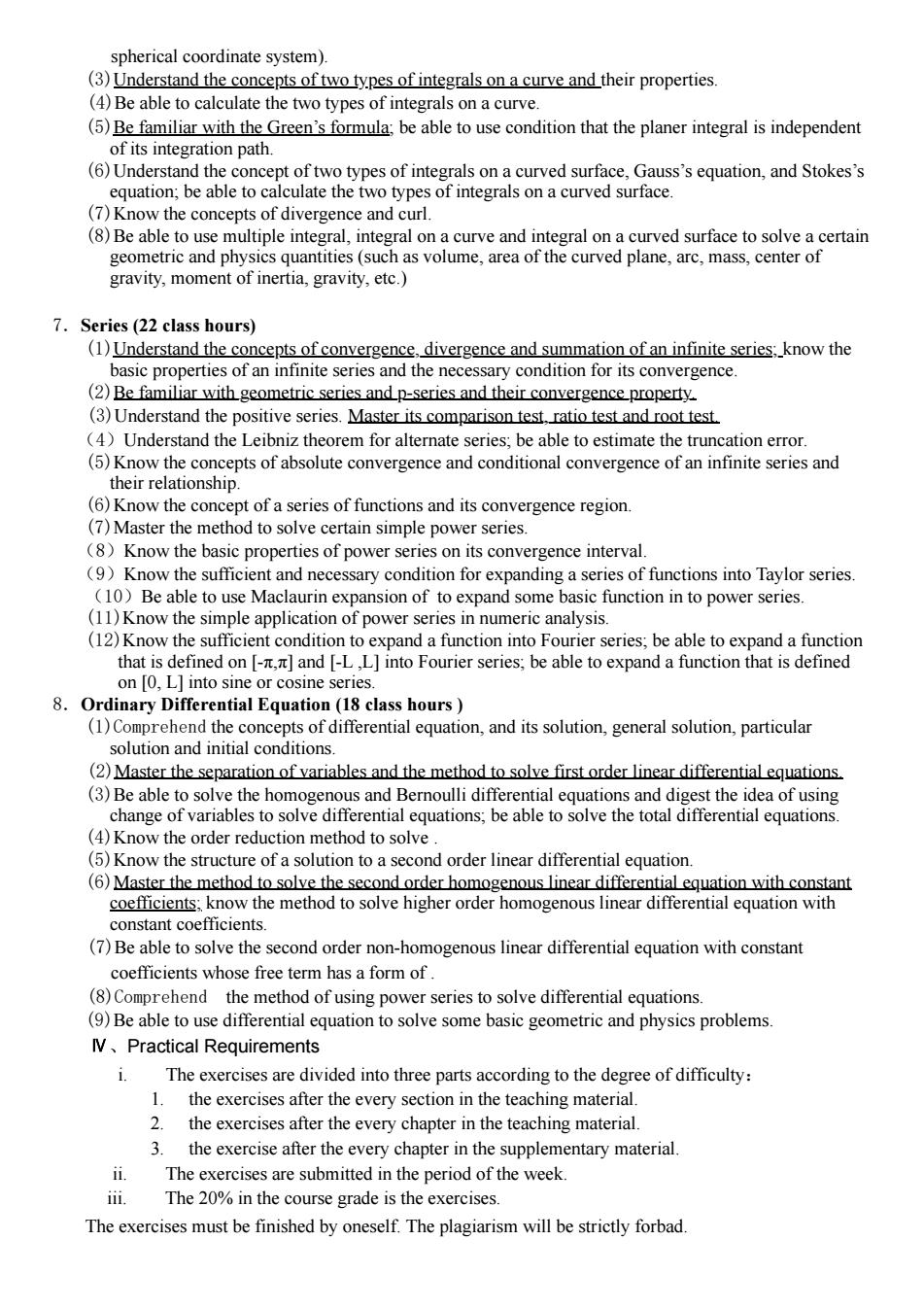
spherical coordinate system) (3)Understand the concepts of two types of integrals on a curve and their properties. (4)Be able to calculate the two types of integrals on a curve. the Green's formula;be able to use condition that the planer integral is independen n pa (6)Unde th as of in ved surface,Gauss's equation,and Stokes's equation:be able to calculate the two types of integrals on a curved surface (7)Know the concepts of diverg nce and curl (8)Be able to use multiple integral,integral on a curve and integral on a curved surface to solve a certain geometric and physics quantities (such as volume area of the curved plane arc mass center of gravity,moment of inertia,gravity,etc.) 7.Series(22 class hours) (1)Unders basic propw ergenc (2)Be far and nd t (3)Understand the series Master its rison test rstand the Leibni orem for alternate be able to estimate the truncation erro conditiona I convergence of an infinite series and eir re (Mac e :ofa series of functions and its con ergence regio certa e power series oI pow sons convergence interva Know the sufficient and necessary condition for expanding a series of functions into Taylor series. Be able to use Maclaurin expansion of to expand some basic function in to power series. simple applic in numeric analysis 12 nt conditi fined on【,t]and [-L,L]in and a fi n into Fourier series be able to expand a unctior ser ies;be able to expand a function that is defined 8.Ordin iff 8 class hours on and in differential quation,and itssolution,general solution,particular ial c diti (3)Be able to so s an ia emouidtfeeielo3oiNe hateor (4)KD d (5)K rder linear dif (6)Mast ctur equat d der h now the method to solve higher order ear dif论 ential on with co an quation with onstant coefficients (7)Be able to solve the second order non-hom ogen ous linear differential quation with constant hose free term has a form of (8)Comprehend the method of using power series to solve differential equations (9)Be able to use differential equation to solve some basic geometric and physics problems I Practical Requirements The exercises are divided into three parts according to the degree of difficulty: 1. the exercises after the every section in the teaching material 2 the exercises after the every chapter in the teaching material. the exercise after the every chapter in the supplementary materia The exercises are submitted in the period of the weel The 20%in the course grade is the exercises. The exercises must be finished by oneself.The plagiarism will be strictly forbad
spherical coordinate system). (3)Understand the concepts of two types of integrals on a curve and their properties. (4)Be able to calculate the two types of integrals on a curve. (5)Be familiar with the Green’s formula; be able to use condition that the planer integral is independent of its integration path. (6)Understand the concept of two types of integrals on a curved surface, Gauss’s equation, and Stokes’s equation; be able to calculate the two types of integrals on a curved surface. (7)Know the concepts of divergence and curl. (8)Be able to use multiple integral, integral on a curve and integral on a curved surface to solve a certain geometric and physics quantities (such as volume, area of the curved plane, arc, mass, center of gravity, moment of inertia, gravity, etc.) 7.Series (22 class hours) (1)Understand the concepts of convergence, divergence and summation of an infinite series; know the basic properties of an infinite series and the necessary condition for its convergence. (2)Be familiar with geometric series and p-series and their convergence property. (3)Understand the positive series. Master its comparison test, ratio test and root test. (4)Understand the Leibniz theorem for alternate series; be able to estimate the truncation error. (5)Know the concepts of absolute convergence and conditional convergence of an infinite series and their relationship. (6)Know the concept of a series of functions and its convergence region. (7)Master the method to solve certain simple power series. (8)Know the basic properties of power series on its convergence interval. (9)Know the sufficient and necessary condition for expanding a series of functions into Taylor series. (10)Be able to use Maclaurin expansion of to expand some basic function in to power series. (11)Know the simple application of power series in numeric analysis. (12)Know the sufficient condition to expand a function into Fourier series; be able to expand a function that is defined on [-π,π] and [-L ,L] into Fourier series; be able to expand a function that is defined on [0, L] into sine or cosine series. 8.Ordinary Differential Equation (18 class hours ) (1)Comprehend the concepts of differential equation, and its solution, general solution, particular solution and initial conditions. (2)Master the separation of variables and the method to solve first order linear differential equations. (3)Be able to solve the homogenous and Bernoulli differential equations and digest the idea of using change of variables to solve differential equations; be able to solve the total differential equations. (4)Know the order reduction method to solve . (5)Know the structure of a solution to a second order linear differential equation. (6)Master the method to solve the second order homogenous linear differential equation with constant coefficients; know the method to solve higher order homogenous linear differential equation with constant coefficients. (7)Be able to solve the second order non-homogenous linear differential equation with constant coefficients whose free term has a form of . (8)Comprehend the method of using power series to solve differential equations. (9)Be able to use differential equation to solve some basic geometric and physics problems. Ⅳ、Practical Requirements i. The exercises are divided into three parts according to the degree of difficulty: 1. the exercises after the every section in the teaching material. 2. the exercises after the every chapter in the teaching material. 3. the exercise after the every chapter in the supplementary material. ii. The exercises are submitted in the period of the week. iii. The 20% in the course grade is the exercises. The exercises must be finished by oneself. The plagiarism will be strictly forbad
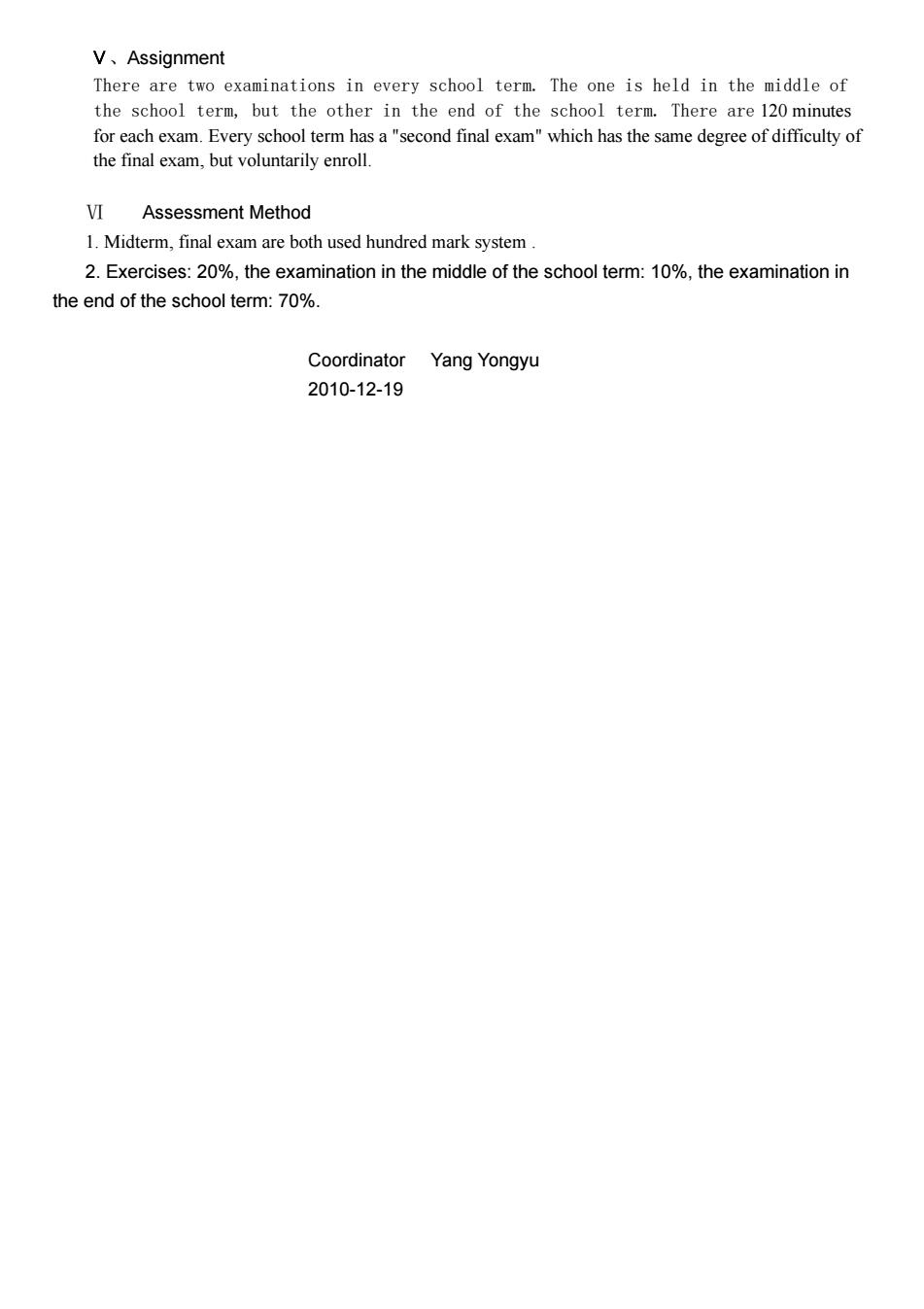
V、Assignment There are two examinations in every school term.The one is held in the middle of the school term,but the other in the end of the school term.There are 120 minutes for each exam.Every school term has a "second final exam"which has the same degree of difficulty of the final exam,but voluntarily enroll. VI Assessment Method 1.Midterm,final exam are both used hundred mark system. 2.Exercises:20%,the examination in the middle of the school term:10%,the examination in the end of the school term:70%. Coordinator Yang Yongyu 2010-12-19
Ⅴ、Assignment There are two examinations in every school term. The one is held in the middle of the school term, but the other in the end of the school term. There are 120 minutes for each exam. Every school term has a "second final exam" which has the same degree of difficulty of the final exam, but voluntarily enroll. Ⅵ Assessment Method 1. Midterm, final exam are both used hundred mark system . 2. Exercises: 20%, the examination in the middle of the school term: 10%, the examination in the end of the school term: 70%. Coordinator Yang Yongyu 2010-12-19